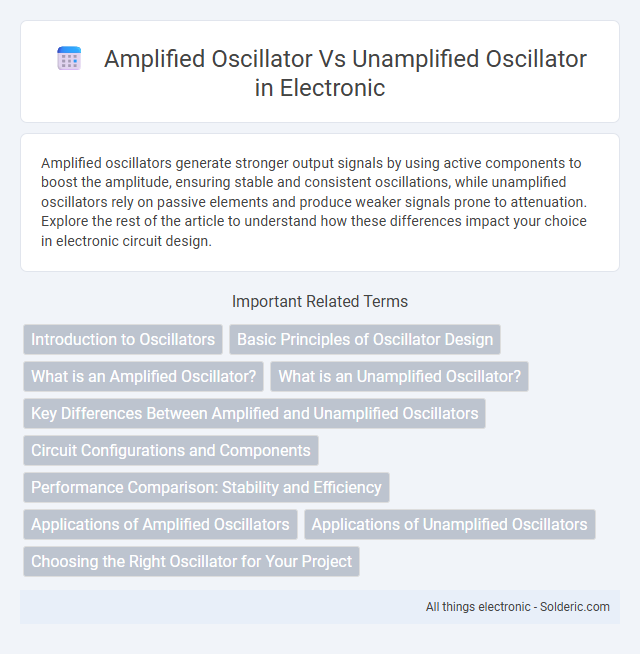Amplified oscillators generate stronger output signals by using active components to boost the amplitude, ensuring stable and consistent oscillations, while unamplified oscillators rely on passive elements and produce weaker signals prone to attenuation. Explore the rest of the article to understand how these differences impact your choice in electronic circuit design.
Comparison Table
| Feature | Amplified Oscillator | Unamplified Oscillator |
|---|---|---|
| Signal Strength | High output due to amplification | Low output, no amplification |
| Stability | More stable frequency with feedback control | Less stable, frequency varies easily |
| Frequency Accuracy | High accuracy with amplification loop | Lower accuracy, prone to drift |
| Power Consumption | Higher power usage due to amplifier circuit | Lower power consumption |
| Complexity | More complex design with active components | Simpler design, passive components only |
| Applications | Used in radios, signal generators, communication devices | Used in low-power or passive circuits, basic timing uses |
Introduction to Oscillators
Oscillators generate periodic waveforms essential in communication and signal processing systems. Amplified oscillators use active components such as transistors or operational amplifiers to maintain continuous oscillations with stable frequency and amplitude. Unamplified oscillators rely on passive components like crystals or LC circuits, producing oscillations without external energy gain but often with limited amplitude stability and lower output power.
Basic Principles of Oscillator Design
Amplified oscillators use active components like transistors or operational amplifiers to provide the necessary gain and sustain oscillations, ensuring a stable output signal with consistent amplitude. Unamplified oscillators rely solely on passive components such as inductors and capacitors, and although simpler, they generally produce weaker signals that may require external amplification. Understanding these basic principles of oscillator design helps you select the right type based on the desired signal strength and application requirements.
What is an Amplified Oscillator?
An amplified oscillator is an electronic circuit that generates a continuous periodic signal by using an amplifier to maintain the oscillation. It relies on positive feedback from the amplifier to compensate for energy losses, ensuring steady and stable signal output. Your choice of an amplified oscillator can improve signal strength and stability compared to an unamplified oscillator, which lacks active amplification.
What is an Unamplified Oscillator?
An unamplified oscillator generates periodic signals without using any active amplification components like transistors or operational amplifiers, relying solely on passive elements such as inductors, capacitors, and resistors. It produces low-power oscillations typically suitable for simple, low-frequency applications where signal strength is less critical. Your choice between amplified and unamplified oscillators depends on the required signal amplitude and application complexity.
Key Differences Between Amplified and Unamplified Oscillators
Amplified oscillators incorporate an active electronic component such as a transistor or operational amplifier to increase the amplitude and stability of the output signal, while unamplified oscillators rely solely on passive components like LC circuits or crystal resonators for frequency generation. The amplified oscillator offers improved signal strength, better frequency accuracy, and enhanced waveform purity compared to unamplified types, which have lower power output and are more susceptible to environmental variations. Understanding these key differences can help you select the appropriate oscillator for applications requiring precise and stable signal generation.
Circuit Configurations and Components
Amplified oscillators incorporate active components such as transistors or operational amplifiers alongside passive elements like resistors, capacitors, and inductors, enabling signal gain and sustained oscillations through feedback loops. Unamplified oscillators rely solely on passive components arranged in configurations like LC or RC tanks, generating oscillations without external power, resulting in lower output amplitude and sensitivity. Your choice between amplified and unamplified oscillator circuits depends on the required signal strength, stability, and complexity of the electronic design.
Performance Comparison: Stability and Efficiency
Amplified oscillators exhibit higher stability due to active components that compensate for amplitude variations, resulting in consistent waveform outputs over time. Unamplified oscillators, relying solely on passive components, tend to suffer from amplitude decay and frequency drift, reducing overall efficiency. Amplified designs consume more power but achieve better signal coherence, while unamplified oscillators offer simplicity with lower power usage but less stable performance.
Applications of Amplified Oscillators
Amplified oscillators are essential in applications requiring stable and high-power signals, such as radio transmitters, signal generators, and communication systems. They provide amplified output that drives antennas and transmitters effectively, ensuring long-distance signal propagation and high-frequency stability. This amplification enables their use in radar systems, audio equipment, and instrumentation where signal strength and clarity are paramount.
Applications of Unamplified Oscillators
Unamplified oscillators are commonly used in applications requiring simple, low-power signal generation such as clock pulses in digital circuits and basic timing references. These oscillators generate stable periodic signals without the need for external amplification, making them ideal for low-noise and low-distortion environments in sensor and radio frequency circuits. You will find unamplified oscillators in precision measurement devices and quartz crystal oscillators where signal purity is critical.
Choosing the Right Oscillator for Your Project
Selecting the right oscillator depends on the desired signal strength and stability; amplified oscillators provide a higher output amplitude suitable for driving complex circuits and long transmission lines, whereas unamplified oscillators offer simpler designs with lower power consumption ideal for compact, low-noise applications. Amplified oscillators typically incorporate an internal gain stage to boost the signal, ensuring consistent waveform quality under varying load conditions. Unamplified oscillators rely on passive components alone, making them more cost-effective and efficient but less capable of maintaining signal integrity over extended distances.
Amplified oscillator vs Unamplified oscillator Infographic

 solderic.com
solderic.com